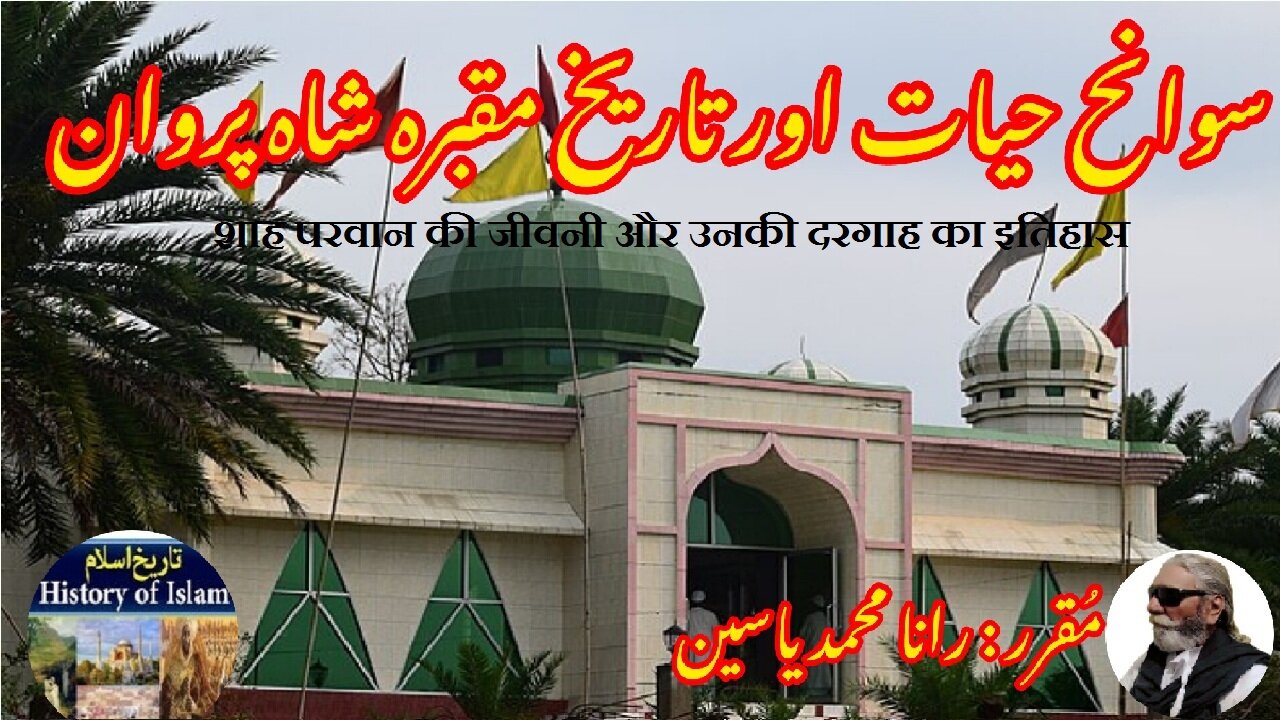Premium Only Content

Shah Parwan and his Shrine शाह परवान और उसकी दरगाह شاہ پروان کی سوانح حیات اور مزار کی تاریخ
@islamichistory813 #shah #parwan #sufisaint #cultural #heritage #biography #islamic #mysticism #islamic #philosophy #shrine #historical #figures
Biography of Shah Parwan and the history of his shrine
Dekhti Aankhooon aur sountay kaanoon ko Asslamoalaikum, sisters, brothers friends and elders, in informative series videos of Islamic ascolars, sufisaints, cultural heritages, islamic philosophys, islamic mysticisms and historical figures. today we are describing biography of Shah Parwan and the history of his shrine.
Shah Parwan, a prominent 14th-century Sufi saint of the Sylhet region, holds a respected place in the spiritual and historical legacy of Bengal. He is best remembered for his participation in the historic 1303 conquest of Sylhet, a decisive event that marked the spread of Islam in the northeastern part of the Indian subcontinent. Shah Parwan was not only a devout Sufi mystic but also a close disciple and the maternal nephew of the legendary Sufi saint Hazrat Shah Jalal Mujarrad al-Yemeni, who led the spiritual and military campaign against the local Hindu ruler, Gour Govinda. Shah Parwan’s involvement in this campaign highlighted his deep spiritual devotion and commitment to the cause of spreading Islam through both peaceful preaching and resistance against oppression. Alongside 360 other companions of Shah Jalal, Shah Parwan traveled to Sylhet, and following the successful conquest, he chose to settle in the region and continued his life as a spiritual guide and missionary.
The conquest of Sylhet in 1303 was not just a political victory but a significant moment in the religious transformation of the region. The local Hindu ruler, Gour Govinda, was known for his persecution of Muslims, and his oppressive actions had prompted the intervention of Shah Jalal and his followers. After the decisive battle, many of Shah Jalal's companions dispersed throughout Sylhet and neighboring areas to preach Islam and establish khanqahs (Sufi lodges) to serve the spiritual needs of the growing Muslim community. Shah Parwan was among those who stayed behind, dedicating his life to guiding the local people, offering religious instruction, and promoting the values of Sufi Islam—peace, love, humility, and devotion to God. He became a widely respected figure in Sylhet, not only because of his association with Shah Jalal but also due to his own piety, wisdom, and ability to connect with people of different backgrounds.
Shah Parwan passed away sometime in the latter part of the 14th century. While the exact year of his death remains uncertain due to the scarcity of written records from that era, local oral traditions and historical accounts agree that he died in Sylhet, where he had spent most of his post-conquest life. Upon his death, his followers and admirers constructed a shrine (mazar) over his grave to honor his memory and spiritual legacy. This shrine became a center of pilgrimage and devotion for the people of Sylhet and beyond, symbolizing the gratitude and reverence of the local Muslim community toward one of their earliest spiritual pioneers.
The shrine of Shah Parwan is located in the Sylhet region, though its exact location is less widely known or documented than the more prominent shrine of Shah Jalal. Nonetheless, it is cherished by those who are aware of its significance, particularly among the descendants of his early disciples and within the circles of local Sufi traditions. The initial structure of the shrine was likely a simple grave covered by a temporary structure made of wood or bamboo, a common practice at the time. Over the years, as the fame of Shah Parwan grew and his importance was further acknowledged by subsequent generations, the shrine was gradually developed and rebuilt using more permanent materials. It is believed that the shrine was first established by Shah Parwan’s direct disciples or family members, who took it upon themselves to preserve the final resting place of their spiritual guide. Later, local rulers, religious scholars, and community leaders contributed to the upkeep and expansion of the shrine, recognizing its role as a center of spiritual and communal activity.
Throughout the centuries, Shah Parwan’s shrine has remained a place of reflection, prayer, and spiritual solace. Pilgrims visit the site to pay their respects, offer *fatiha* (prayers for the deceased), and seek blessings. On the occasion of his *urs* (death anniversary), devotees gather to celebrate his life and teachings through devotional gatherings, recitation of the Qur'an, Sufi music (qawwali), and distribution of food. These events are not only religious observances but also important cultural moments that reinforce the values of Sufism and community harmony.
Shah Parwan’s legacy continues to live on in the collective memory of Sylhet’s people. His contributions to the establishment of Islam in the region, his close relationship with Shah Jalal, and his own personal virtues make him an enduring figure in the spiritual landscape of Bengal. His shrine stands as a symbol of devotion, sacrifice, and the timeless message of love and service that Sufism has always carried. Though not as widely known as his uncle, Shah Parwan’s role in the early Islamic history of Sylhet remains deeply significant, and his resting place continues to inspire those who follow the path of spiritual purity and divine love.
With this, we seek your permission until tomorrow, tomorrow we will describe the biography of Shams Faqir and the history of his Shrine.
Allah Hafiz
==============================
-
 6:21
6:21
ISLAMIC HISTORY
19 hours agoAl-Shifa'a bint Abdullah अल-शिफ़ा बिन्त अब्दुल्ला سوانح عمری الشفاء بنت عبداللہ
9 -
 22:54
22:54
DeVory Darkins
1 day ago $12.13 earnedABC suffers fatal mistake brings Kimmel back on air as Trump makes shocking announcement
27.2K147 -
 19:04
19:04
putther
2 days ago $0.63 earnedTrolling a Level 7981 With My CHERNOBOG on GTA Online!
25.1K2 -
 26:17
26:17
Coin Stories with Natalie Brunell
20 hours agoInside Strive’s Bold Bitcoin Acquisition of Semler Scientific
31.9K2 -
 2:26:57
2:26:57
The Robert Scott Bell Show
19 hours agoTrump Autism Announcment, NYC Fluoride Ban, EMF Concerns, Kimmel Returns (Sort of), Plastics & Childhood Disease - The RSB Show 9-23-25
12.5K8 -
 9:33
9:33
Dr Disrespect
5 days agoDoc Goes PSYCHOTIC
133K15 -
 11:22
11:22
Nikko Ortiz
1 day agoExpensive Military Fails
15.8K5 -
 41:10
41:10
The Connect: With Johnny Mitchell
3 days ago $4.18 earnedInside The Sinaloa Cartel's Fight For Survival: How Mexico's Oldest Cartel Is Making It's Last Stand
20.3K10 -
 5:43
5:43
GritsGG
14 hours agoBest Way To Get Specialist EVERY Game!
15.4K2 -
 1:44:47
1:44:47
Side Scrollers Podcast
20 hours agoKimmel RETURNS + Twitch University + More! | Side Scrollers
45.8K5